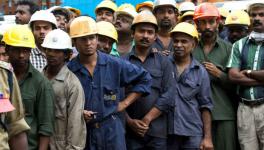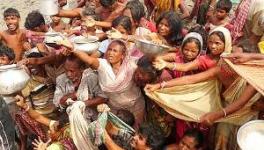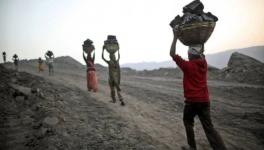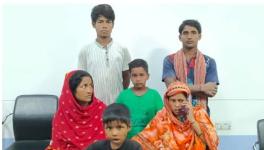Centre Pins Hopes on two Surveys for Growth Strategy With Job Creation
Kolkata: The Union Labour Ministry's two surveys – one on migrant workers and the other on domestic workers – have made considerable progress, and it should be possible for designated teams comprising, among others, senior economists and statistical experts, to finalise their reports in six months or so.
The exercise marks New Delhi’s realisation that employment generation and the well-being of workers have to be a key concern in the long-term economic growth strategy, formulation of which will be facilitated if evidence-based inputs derived from surveys and analysis thereof are available, according to Amitav Kundu, Professor Emeritus at Ahmedabad-based Lok Jagruti University, who is closely associated with the Labour Ministry’s initiative.
Kundu, who earlier taught economics at Jawaharlal Nehru University, said the 45-year peak in the unemployment rate at 6.1% registered in 2017-18 and the COVID pandemic that persisted over two years wrought extensive damage to the economy, with employment generation being worst hit. The authorities have realised that for sustainable economic benefits, it has to be growth with job creation.
“Increase in capital intensity may give us growth for some time, but it could be jobless growth, which is neither sustainable nor desirable”, Kundu told NewsClick. This route for growth would, over time, trigger massive disenchantment in the labour market, he added.
The survey of migrant workers is trying to identify places they come from, their level of education, if any, the trades they are engaged in and the wages they were earning before the COVID outbreak, how the situation deteriorated during the pandemic, whether the ground realities obtaining indicate some improvement and what should be the do’s and don'ts to minimise chances of future shocks.
Employer-migrant worker relationships, too, will be examined to determine initiatives necessary to improve a lot of the millions of migrant workers. It is not that legislative safeguards are wanting, but administrative actions at the levels of the Centre and the states have remained an apology for implementation. That’s the assessment of several experts.
The survey of domestic workers will hopefully throw light on many little-known aspects of this fairly large wage-earner segment of the economy. Domestic workers, which may be reckoned as a generic identity, include persons performing tasks such as cleaning the house, cooking, washing and ironing clothes, taking care of children or elderly or sick members of a family, gardening, guarding the house, driving for the family and even taking care of household pets. Under the ILO Convention 189, a domestic worker is “any person engaged in domestic work within an employment relationship”.
But, domestic workers belong to the unorganised sector, and are largely unorganised. Male and female segmentation apart, there are issues related to child labour, live-in and live-out categories, maltreatment bordering on cruelty and inclusion in Scheduled Employment by states. Their protection under Domestic Workers (Registration, Social Security and Welfare) Act 2008, which is a Central legislation, has to be ensured through follow-up legislation by states. There are other legislations, too, and there is the National Domestic Worker Movement.
The Union government, according to Kundu, also wants to assess the outcome of schemes, such as cash payment of Rs 6,000 to each farmer, SMILE (Support for Marginalised Individuals for Livelihood and Enterprise, PM-Daksh (Pradhan Mantri Dakshta Aur Kushalta Sampann Hitgrahi, PMKVY (Pradhan Mantri Kaushal Vikas Yojana, Start Up India Scheme and, of course, MNREGA. Asked how we explain the labour market, he said the concept basically refers to a mechanism wherein supply – persons wanting to sell their labour – and demand – people wanting to buy labour interact and “produce employment and earning outcomes”.
Those wanting to buy labour may offer regular or casual employment, depending upon requirements. It may be mentioned that the VV Giri National Labour Institute has an exclusive research centre called the Centre for Labour Market Studies, which undertakes research focusing on the ongoing transformation in the labour market, which is intricately linked to markets for capital, goods and services.
Knowledgeable quarters told NewsClick that surveys are expected to take into account the types of unemployment to aid policy formulation. The types broadly are:
(1) Disguised unemployment: It is a phenomenon wherein more people are engaged than actually needed; seen mostly in agricultural and unorganised sectors
(2) Seasonal unemployment: This occurs during certain seasons in a year; farm workers in India rarely have jobs throughout the year
(3)Structural unemployment: This arises from a mismatch between jobs available in the market and the skills of available workers
(4)Cyclical unemployment: This results from business cycles; joblessness rises during recessions and falls with economic growth; not quite pronounced in India, but common in capitalist economies
(5)Technological unemployment: Loss of jobs attributable to changes in technology; automation is a major reason
(6)Frictional unemployment: Also called search unemployment; refers to the time lag between jobs when an individual is searching for a new job or is switching between jobs – in a sense, it is an instance of voluntary unemployment as one looks for better opportunities and
(7)Vulnerable unemployment: Reference is to people working informally, without proper job contracts and, of course, without legal protection; they are deemed unemployed, for there are no records. This is a serious issue in India.
NewsClick spoke to two trade union leaders to get their view on the Labour Ministry's initiative, and though both the leaders belong to the Left, divergence in their views was rather conspicuous.
Tapan Sen, general secretary of the Centre of Indian Trade Unions (CITU), which is aligned with the Communist Party of India (Marxist), asked: “What about industrial workers; can this be an inclusive survey that will genuinely aid policy formulation for employment generation? Widespread unemployment has wrought serious damage to the economy and the BJP-led NDA government, under Narendra Modi’s prime ministership, hardly ever utters a pro-worker word. They have undertaken a survey of migrant workers after nullifying whatever protective legislation was there for their livelihood, safety and social justice. They have made workers dependent on contractors’ mercy. The 1979 enactment has been repealed.”
The CITU leader added, “Despite the Supreme Court’s strictures, the Centre does precious little to improve its lot. For domestic workers, there is no provision for registration, and New Delhi is yet to ratify ILO Convention for a protective mechanism. See the lot of gig economy workers; they are at the mercy of the person or agency that controls the App. "To me, the survey exercise is nothing but eyewash.”
Ashok Ghosh, general secretary of United Trade Union Congress (UTUC), aligned to the Revolutionary Socialist Party, who recently had a meeting with Union Labour Minister Bhupendra Yadav, sees the surveys in a different light even as he refers to the dire unemployment situation.
The surveys covering the largest chunk of unorganised labour with skeletal governmental livelihood support will hopefully identify the spheres for immediate, short, medium, and long-term inventions to improve their lot and create avenues for regular employment with a social safety net, Ghosh says.
"I think the Union Minister is serious about the survey findings, and as a responsible outfit, UTUC sees it as a well-intentioned move. Labour markets everywhere have seen bad times during and after COVID-19. Ground realities differ from country to country; only an in-depth study can help prepare an economic growth plan with job creation as a key objective,” he tells NewsClick.
“Positive stance on the survey does not in any manner dilute our fight for workers’ cause. Remember that every year the number of jobseekers swells as youths finish their education, and the less fortunate ones are required to support their family," he observes.
For the record: In an article in The Telegraph of October 7, Anup Sinha, former professor of economics at IIM Calcutta, has observed: “The tolls that the pandemic took on education and health infrastructures are likely to have long-lasting adverse effects on society. If one adds to these data – mostly obtained from non-government sources – the changes in poverty levels, unemployment, informalisation of the labour force, the overcrowding in the agriculture sector, a shrinking of the MSME sector by almost half, and the shocking increase in economic inequalities, the underbelly of the Indian economy would be fully revealed.”
Citing World Bank’s warning that India’s uneven recovery could soon falter, The Hindu editorial on October 8 observes: “Private consumption, in particular, will be affected this year and next, the Bank has reckoned, especially as the pandemic’s scars on income and employment levels persist for rural and low-income households. As many as 56 million Indians may have slipped below the poverty in 2020, it estimated. The government has been gung-ho about “entering an era of robust growth”, but its decision to “extend free foodgrains programme suggests it realises that not all actors of the economy have managed to get out of the woods yet”.
The opening three sentences of an article on “Why do migrants remain excluded in present-day India”, Priya Deshingkar, Professor of Migration and Development at the School of Global Studies, University of Sussex, UK, writes: "More than 70 years after Independence, India continues to struggle to fairly distribute the benefits of growth, development and welfare to large parts of the population that remain, socially, politically and economically excluded. Among these, migrants belonging to the poorer strata of society are arguably among the most excluded from exercising their rights as citizens of India. This includes men, women and children belonging to dalit communities, Adivasis, poorer artisan castes, certain religious minorities, and other disadvantaged groups”.
Get the latest reports & analysis with people's perspective on Protests, movements & deep analytical videos, discussions of the current affairs in your Telegram app. Subscribe to NewsClick's Telegram channel & get Real-Time updates on stories, as they get published on our website.
























